Rennes Historic Centre | A Guide to the City’s Stunning Medieval Streets
Take a stroll in Rennes historic centre and soon your attention will be drawn to the city’s picturesque half-timbered houses. Dating from the 15th century onwards, they sit askew along some of Rennes’s most beautiful streets. Leaning against each other or tilting questionably as if they were about to collapse on you, half-timbered houses give Rennes historic centre a fairytale-like atmosphere.
Timber-framed houses were popular all over Brittany in medieval times. Even though a catastrophic fire destroyed a large part of Rennes’s old quarter in 1720, the Breton capital has remained the place in Brittany where half-timbered houses are the most prevalent. Mostly located in the city’s historic quarter, 370 houses are thought to remain.
Dotting the city here and there, half-timbered houses can also be seen lining entire streets of Rennes. Wandering through the old Breton streets is like taking a step back in time. Shops and restaurants have often replaced what used to be homes and workshops. But the visitor’s mind is easily drawn to imagine how life might have been during medieval times thanks to these vibrant buildings that have survived more than six centuries.
Follow this guide through Rennes historic centre and discover the city’s stunning medieval streets full of architectural gems.
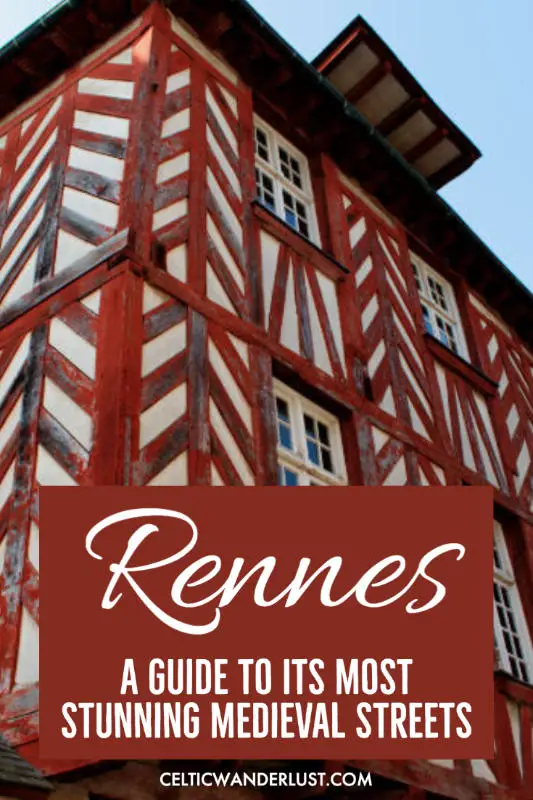
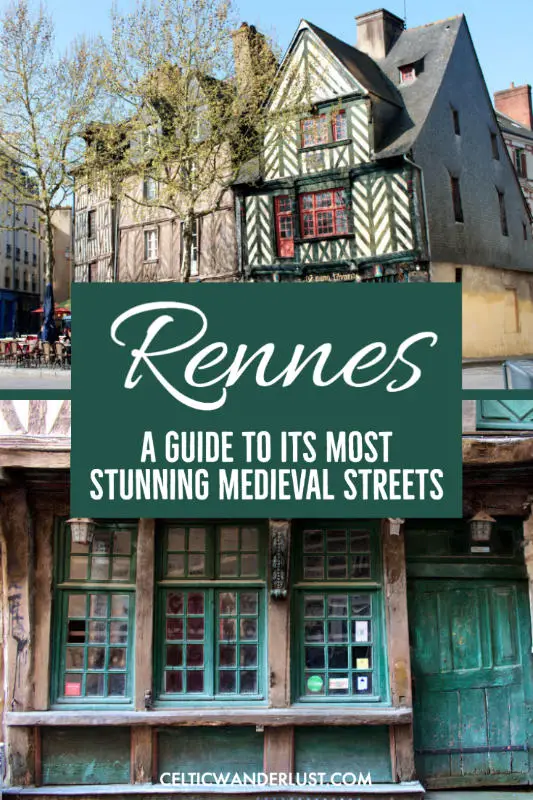
Rue Saint-Georges
Rue Saint-Georges is one of Rennes’s most popular streets. Pedestrianised, the cobbled street found near the Parliament of Brittany is full of small shops, restaurants, pizzerias and, of course, delicious crêperies.
Some of Rennes’s oldest buildings can be found in Rue Saint-Georges. In fact, this street is very much characteristic of the city’s architectural evolution from the 15th to the 18th centuries.
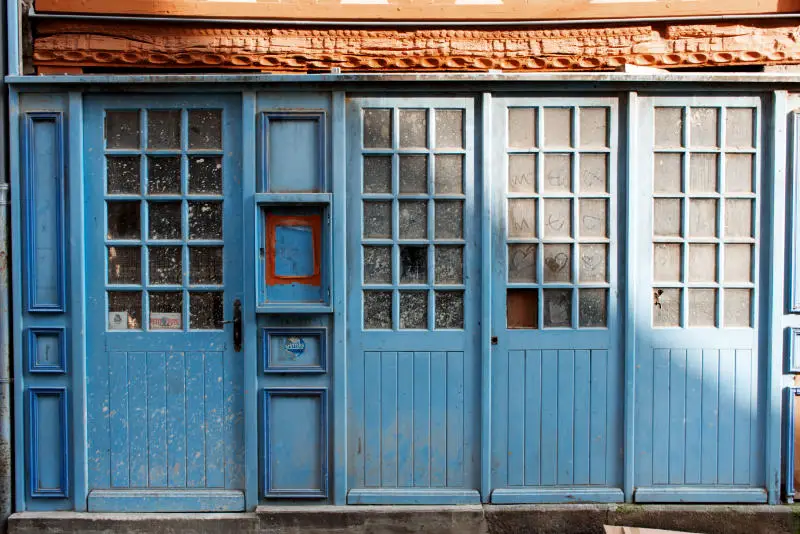
The narrow half-timbered houses found in Rue Saint-Georges are typical from the medieval 15th century. Modest workshops and shopkeepers occupied the ground floor while humble lodgings no more than a few metres wide were rented out on the floors above. Some buildings were even too narrow to install stairs so a ladder would have to be used to access the upper floors. With just a window at the front and possibly at the back, these tight but deep apartments were rather dark even during the day.
In the 16th century though, the Italian Renaissance had made its way to Brittany. A change in lifestyle was introduced that required grander homes and more light inside. And the construction of the Parliament nearby started to attract important and rich officers to the neighbourhood. At number 3, the townhouse called Hôtel de la Moussaye was then built on two plots of land, allowing for more windows at the front. This larger house clearly stands out with its sophisticated facade adorned with rare wooden carvings inspired by the Italian Renaissance.
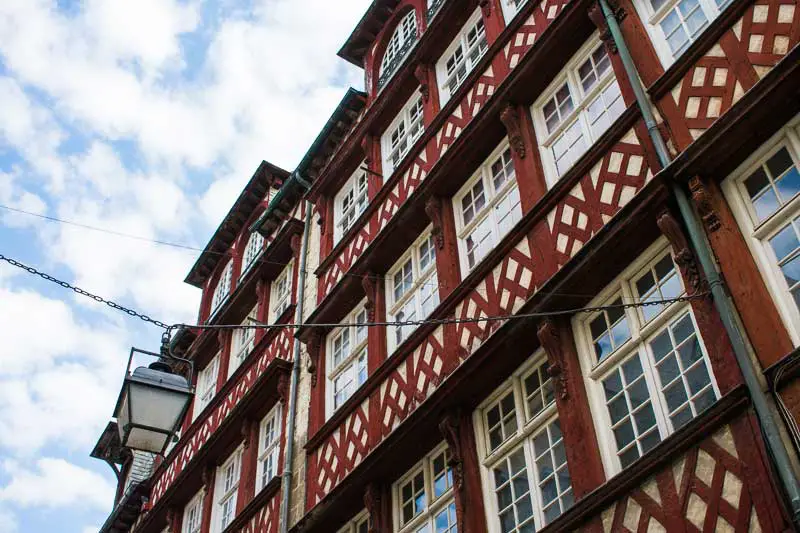
Across from it, at numbers 8 to 14 Librairie Le Failler, Rennes’s largest bookshop catches the eye with its wonderfully well-preserved, timber-framed facade painted in red ochre. The business occupies a collection of impressive, 4-storey high buildings erected as demands for rental lodging increased at the end of the 16th century. But the Renaissance had already been forgotten as plain timber replaced earlier carved wooden facades as the city’s dominant architectural style.
Rue Saint-Melaine
Rue Saint-Melaine is a pedestrianised street leading to Notre-Dame-en-Saint-Melaine, a church dating from the 11th century built at the top of a hill. The street is popular with locals and students for its numerous inexpensive crêperies and restaurants.
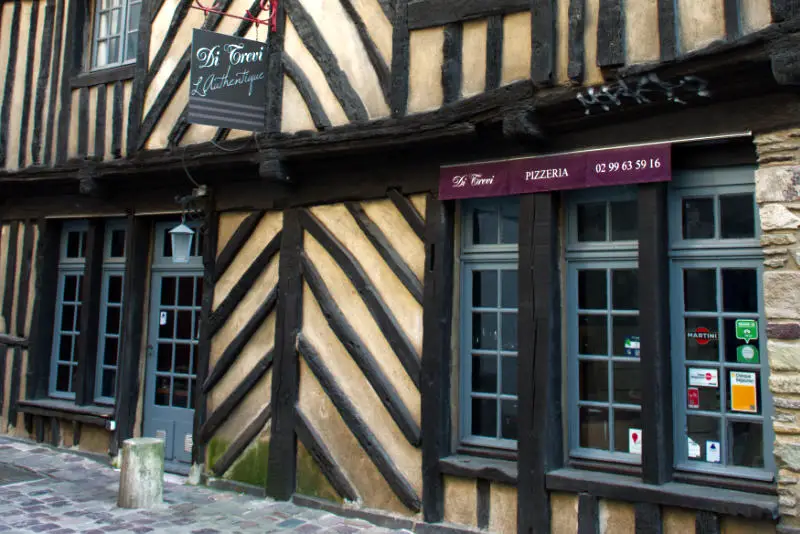
Located in the northern part of Rennes historic centre, Rue Saint-Melaine is another street that escaped the great fire of 1720. Although not entirely lined with half-timbered houses anymore, this street has retained some great examples of ancient architecture.
At number 10 to 16 for instance, a series of adjoining houses from the 17th century display the same chevron patterned facade which has been beautifully restored. These constructions perpetuate the tradition started in the previous century of “apartment blocks” for the rental market.
You might also be interested in:
– Best Places to Visit in Brittany | A Day in Roscoff & the Ile de Batz
– Learning to Surf in La Torche, Top Surf Spot for Beginners in Brittany
Rue Saint-Michel
Rue Saint-Michel is sometimes referred to locally as the “rue de la soif” which translates as “Drinker’s Alley”. Rue Saint-Michel is indeed famous among the student crowd for being one of Rennes’s most popular party scenes. Countless bars and fast food places have now replaced workshops and shops that once filled up the old houses.
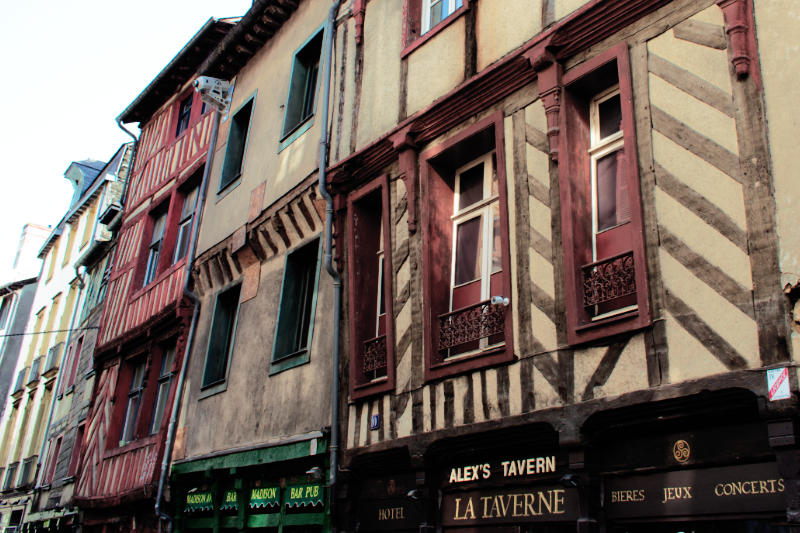
Escaping the 1720 fire unscathed, Rue Saint-Michel is the only street in Rennes that is entirely made of wood. The narrow buildings huddled together along the cobbled street are still following the tight cadastral plan in vogue in medieval times.
Carved beams (check number 14 and its door lintel carved with beautiful lions), chevron and diamond-patterned facades painted in brown, deep red or yellow adorned the street’s 16th century houses.
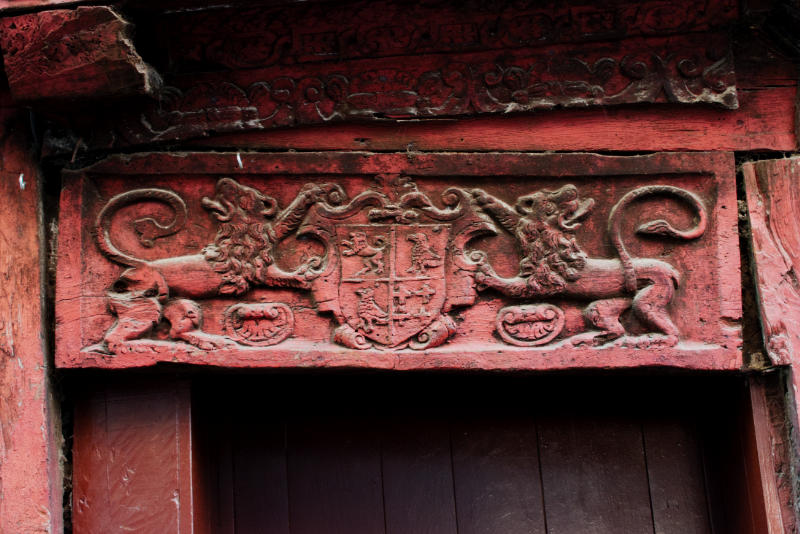
Although left untouched by the great fire, Rue Saint-Michel suffered the following regulations adopted in the 18th century to avoid such disastrous fires from happening again. For instance, wooden sculpted facades were chopped down to allow for wooden laths to be nailed in place and coated with fire “retardant” paint.
More dramatically, owners of corbelled houses with upper floors advancing above the street were ordered to have their facade rebuilt straight. Corbelled houses were considered a major threat, fire spreading from street to street from the houses’ upper levels that almost touched each other. Number 16 had its facade corrected; now flat, the old house has sadly lost most of its medieval character.
Place Sainte-Anne
As you follow Rue Saint-Michel, the street suddenly opens up on Place Sainte-Anne. Dominated by the unfinished Saint-Aubin church, the square attracts the crowds with its numerous bars, cafés and restaurants housed in half-timbered buildings and their sprawling terraces.
With wonderful examples of 16th century architecture, Place Sainte-Anne is worth a detour. Adjacent houses at number 9 and 10 offer a unique opportunity to observe the evolution in style during the Renaissance. Built around 1550, the house at number 10 still follows the medieval tradition with a chevron-patterned facade and religion-themed decor. At number 9, the house built in 1586 displays instead a diamond-patterned facade and a late-medieval Renaissance decor. If you look close enough, you will see that the timber frame above the door was carved with two lions holding the coat of arms of the Kerguelens, an ancient and noble family from Brittany.
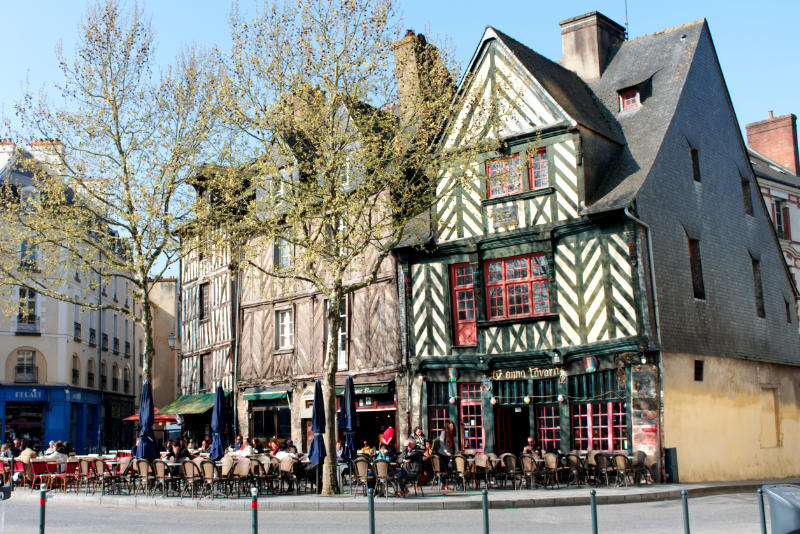
Maybe one of the most striking half-timbered houses on Place Sainte-Anne, Maison Leperdit stands out at number 19 with its unusual green wooden facade. Now a pub, the house belonged to Jean Leperdit, Rennes’s mayor during the French Revolution. Built in 1555, the house’s architecture is clearly steeped in medieval times but the longer facade opening up on the street indicates the adoption of a new style emerging in the 16th century.
Rue Rallier du Baty
Like Place Sainte-Anne, Rue Rallier du Baty is the place to go if you fancy a meal “al fresco”. The restaurants here take full advantage of the little square extending at their doorsteps to set up outdoor dining tables. The half-timbered houses lining one side of the plaza offer a wonderful background for a crepe-filled lunch under the Breton sun.
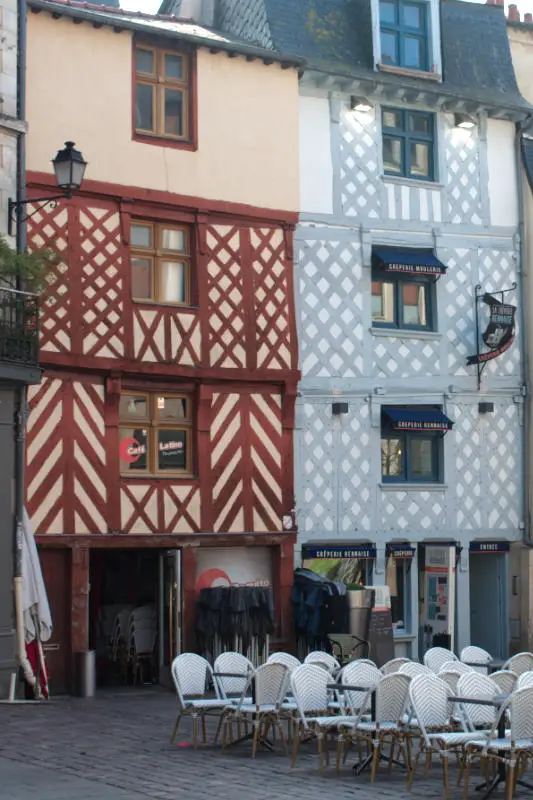
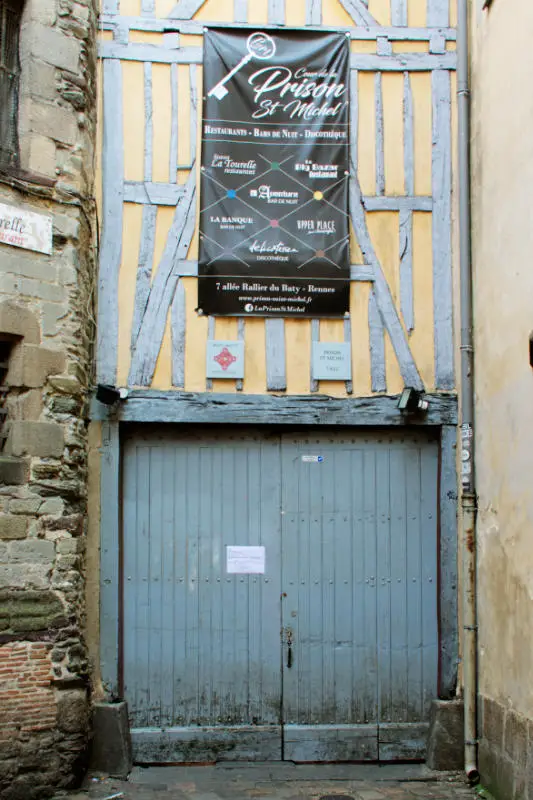
Dating from the 16th century, the timber-framed houses in Rue Rallier du Baty are a joy to look at. Their facades boast the usual chevron and diamond patterns that were the rule back then. The absence of carvings along the timbers and the rather flat facades showing very limited corbelled elements foretell however that they would soon drop out of fashion.
Remains of the city’s 15th century rampart are another point of interest to be found in Rue Rallier du Baty. Also, a side street called Allée Rallier du Baty leads to Prison Saint-Michel, a former 15th century jail now home to trendy bars and clubs. The prison’s door and courtyard are worth a look.
Place du Champ-Jacquet
Jean Leperdit statue turns its back to them, but they are all the eyes can see in Place du Champ-Jacquet. The half-timbered houses dominating the little square seem incredibly tall and more elegant than any other in the city.
From the end of the 16th century and well into the 17th century, Rennes saw the creation of more positions and judicial offices thanks to the Parliament now located in the city. Families of rich magistrates, lawyers, prosecutors settled in Rennes and drove changes in the city’s urban architecture.
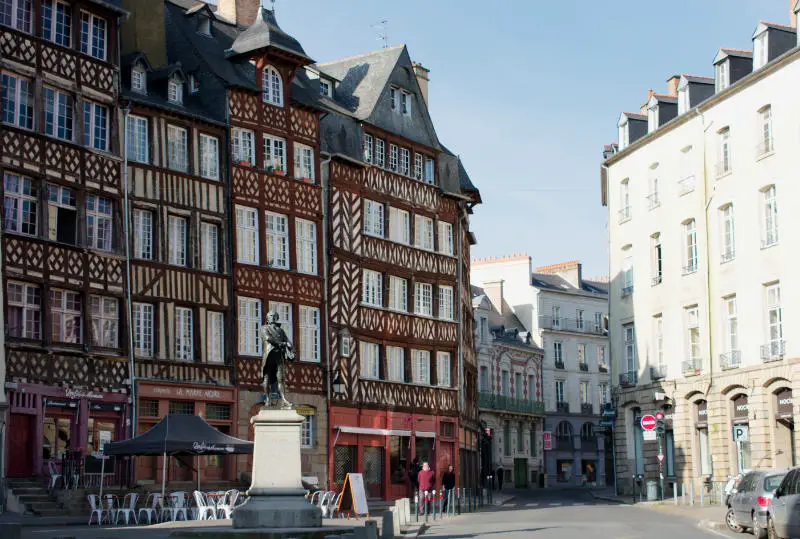
In Place du Champ-Jacquet, architectural innovations introduced in the 17th century embellished the roofs. Influenced by Parisian architecture, rooftops were built in “à l’impériale” and “en pavillon” styles. Their intricate, curved shapes (number 15) and hat-like, pointy frames (number 19) are certainly the most exquisite addition to the city’s skyline.
However, mistakes were also made in Place du Champ-Jacquet. Windows were added along entire facades to let more light into the lodgings. In doing so, the houses lacked sufficient support and they now all look skewed, which is not without charm to be honest.
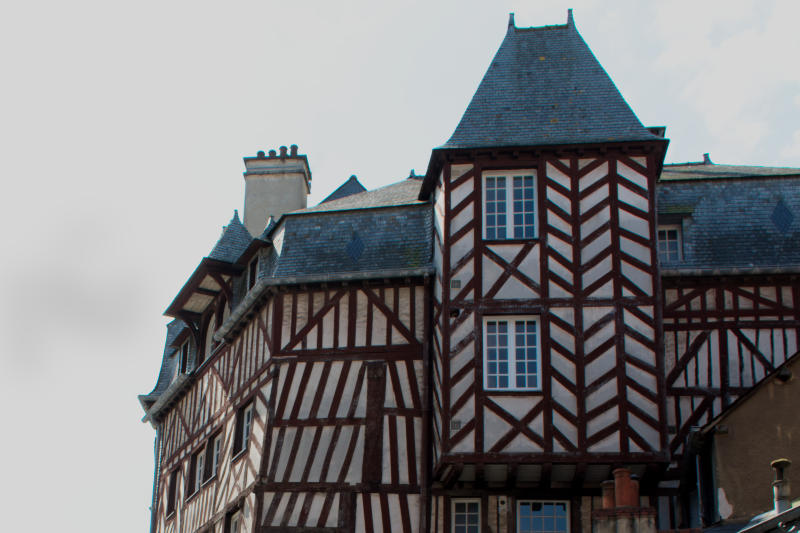
The rich noblemen attracted by the judicial positions on offer in the Breton capital during the 17th century also built luxurious townhouses known as “hôtels particuliers”. One good example stands at number 5, Place du Champ-Jacquet. While its upper levels were still being built out of wood, the ground floor of the Hôtel Hay de Tizé (1665) was made of stone. Although it is the only one in the city to display Doric pilasters, the grand townhouse lacks the symmetry and well proportioned facade dictated by classical architecture.
Place des Lices
Place des Lices is a square known in Rennes for its Saturday food market. People in Rennes have been shopping for local produce at this same spot for more than four centuries.
Once the market is over though and calm has returned to Place des Lices, the attention falls inevitably on two large townhouses north of the square. Hôtel de la Noue and Hôtel Racapé de la Feuillée at number 26 and 28 were two private townhouses erected in the 17th century.
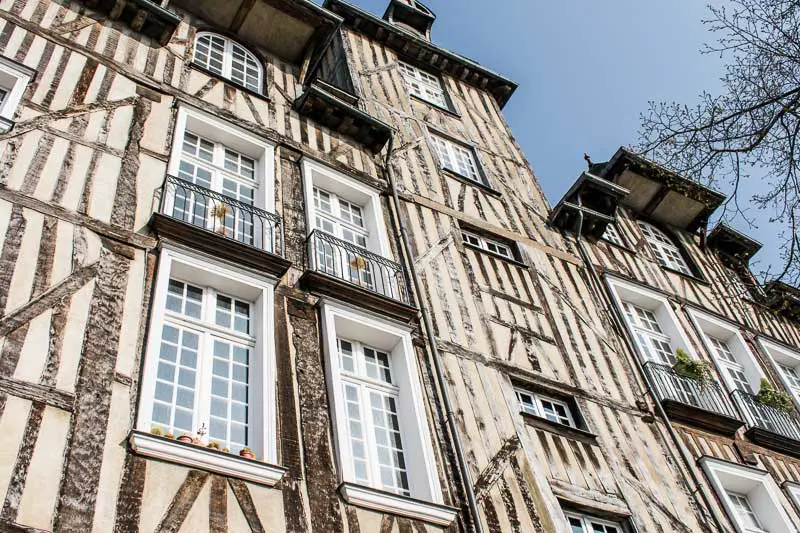
The lack of refinement in their facades must not be taken as a sign of impoverishment though. They were built around large and luxurious staircases positioned at the centre of the houses. The stairwell was crowned with a sophisticated and expensive roof “à l’impériale”, sumptuous craftsmanship showing off the noble status of their owners. The numerous windows on each floor flooded the richly decorated interior with light.
At the bottom of Place des Lices, an interesting piece of heritage hides at the end of a narrow, cobbled street called Rue des Portes Mordelaises. Built in the 15th century, the Portes Mordelaises were the city’s main gates. Highly symbolic, the future Duke or Duchess of Brittany had to swear to protect the Breton liberties before walking through them and be crowned in the cathedral nearby. The gates have retained their medieval appearance and are worth a detour before continuing your visit.
The Cathedral Quarter
Visiting Saint-Pierre Cathedral is without a doubt one of the top things to do in Rennes. Explore the backstreets hiding behind the historic church and you will be amazed by more architectural gems.
The Cathedral Quarter was an old aristocratic neighbourhood with sumptuous townhouses owned by noble families and richly decorated homes of clergymen. Wander Rue Saint-Guillaume, rue du Chapitre, rue Saint-Yves or Rue des Dames to discover wonderful facades, some now listed and protected by the State.
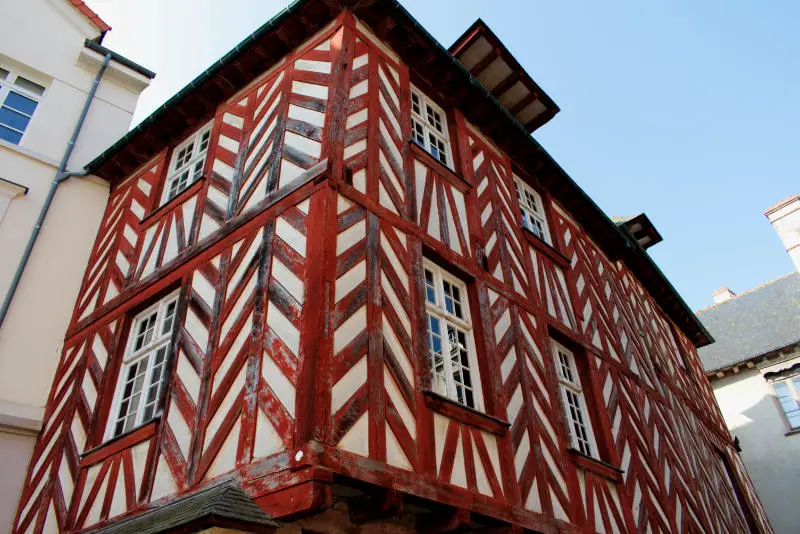
Dating from the early 16th century, house number 3 in Rue Saint-Guillaume is exquisite to look at. Owned by the Church, the house was one of the first attempts to step away from the design of narrow medieval houses. This building has a 10-metre-long facade overlooking the street, allowing more light inside thanks to multiple windows. Following the Gothic style favouring then a religious decor, the two doors at the front are framed with two wooden statues evoking the martyrdom of Saint Sebastian pierced with arrows.
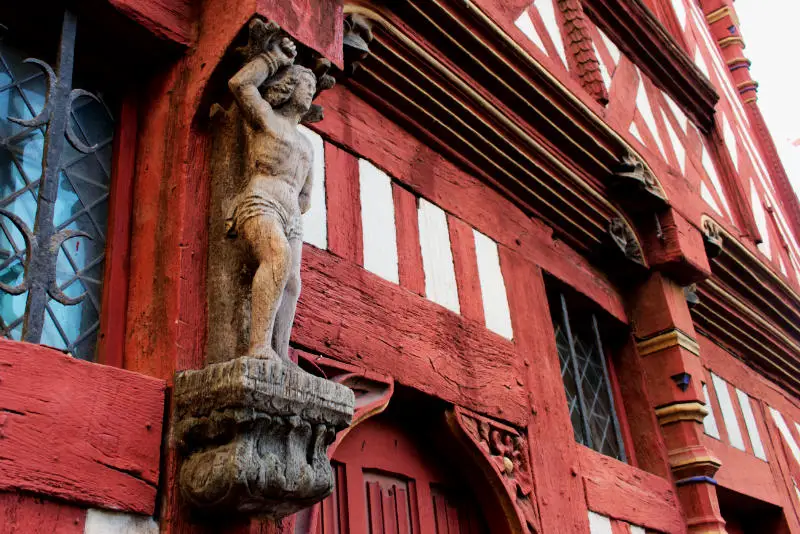
Walking down Rue de la Psalette is like entering a medieval market town. The cobbled street’s half-timbered houses have been beautifully renovated and give a glimpse of what life must have been in medieval times.
At the bottom of the street, at the corner with Rue du Chapitre, stands house number 22, another remarkable listed building. Dating from the end of the 16th century, its beams display an intricate Renaissance decor with lions, griffons and leaves. Next door, the original owners of number 20 had their portraits carved in wood on each side of the central window on the first floor, a fashion inspired by French Renaissance king Francis I.
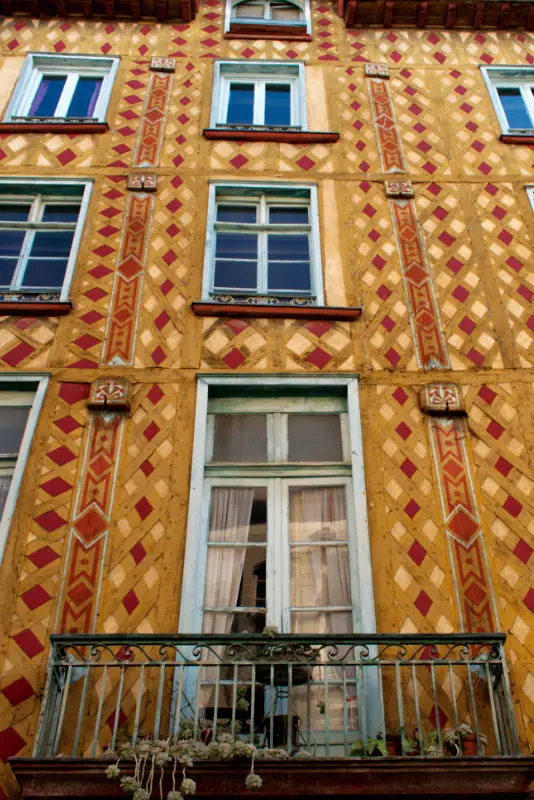
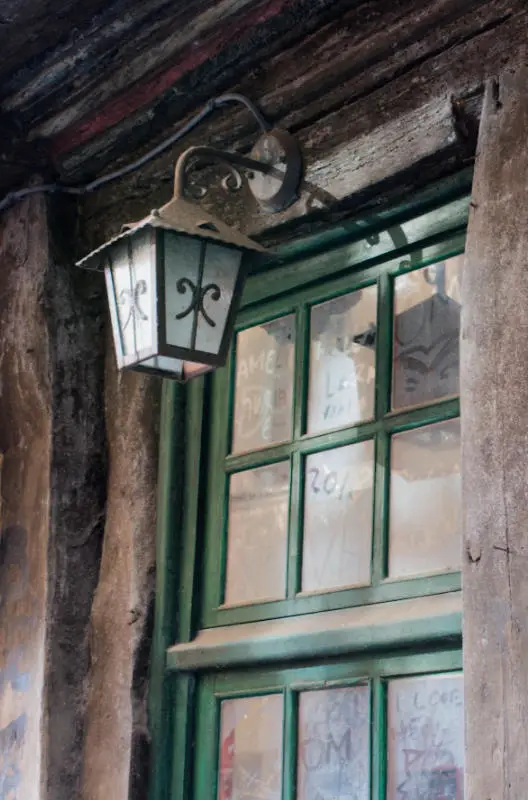
With its front wall painted in vivid red and yellow in refined pattern, the house at number 5 Rue du Chapitre is a rare example of polychrome wooden facade from the 17th century. Next to it, the rather large “hôtel particulier” owned by the aristocratic family Plessis de Grenédan goes back to the 15th century. Its timber-framed upper floors contrast sharply with the Hôtel de Brie (early 17th century) at number 8, one of the first buildings entirely made of stone.
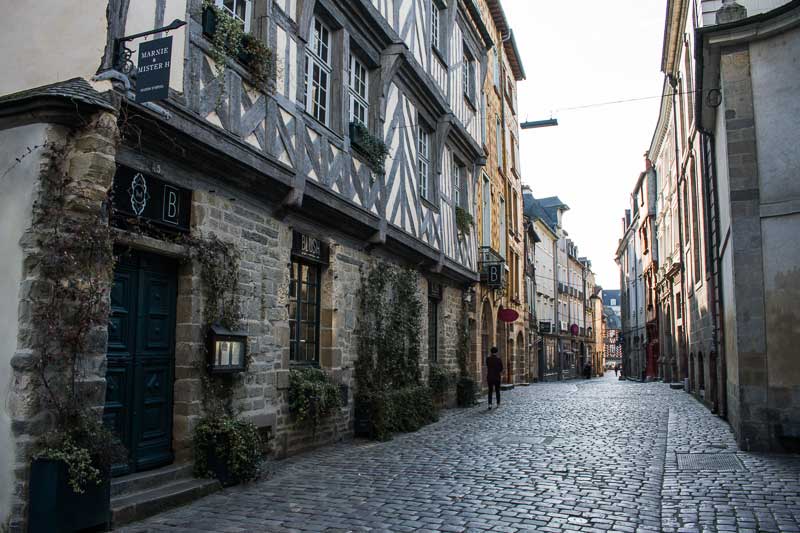
Inhabited by the old aristocracy, the nearby street of Rue des Dames was one of the most sought-after neighbourhoods in Rennes. Old townhouses were updated during the 16th century like the superb Hôtel de Freslon located at number 10 Rue des Dames. Inside, walls were adorned with artworks while coffered ceilings and woodworks were beautifully painted. Unfortunately, these were sold by their owners later on.
Exploring Rennes Historic Centre is to start a journey into the city’s fascinating architectural history. But the wooden houses that make Rennes’s old quarter so irresistible could have been lost forever. The Breton capital was scarred by a dramatic fire in 1720. The following centuries were not kind either towards its remaining half-timbered houses, some being demolished in the name of modernity.
Once doomed to disappear, Rennes’s wooden houses have now been saved. People are making these ancient, quirky buildings in Rennes historic centre their home once again, bringing life back to old neighbourhoods. Rennes has embraced its past, a good enough reason to visit Brittany’s historic capital.
For more historic finds, I recommend heading over to the Bay of Morlaix, just two hours away from Rennes, on Brittany’s northern shore.
Disclaimer: This post may contain affiliate links. If you click on a link, I earn a little money at no extra cost to you.
RELATED POSTS

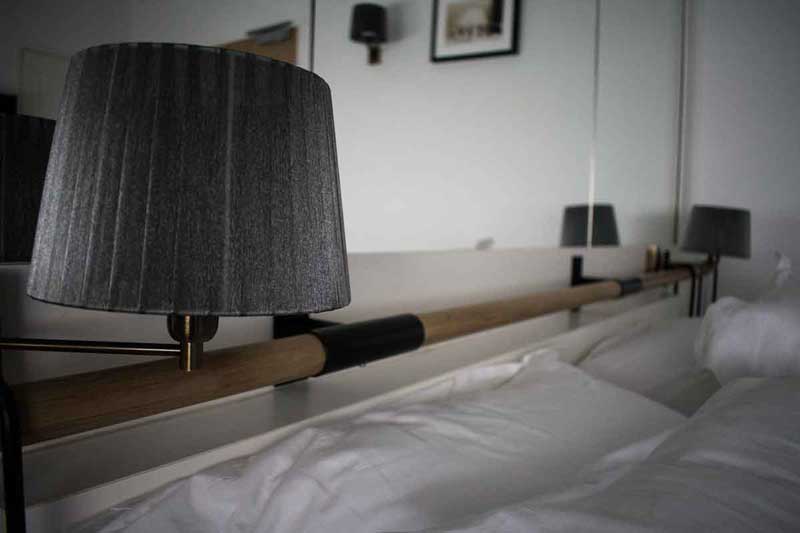
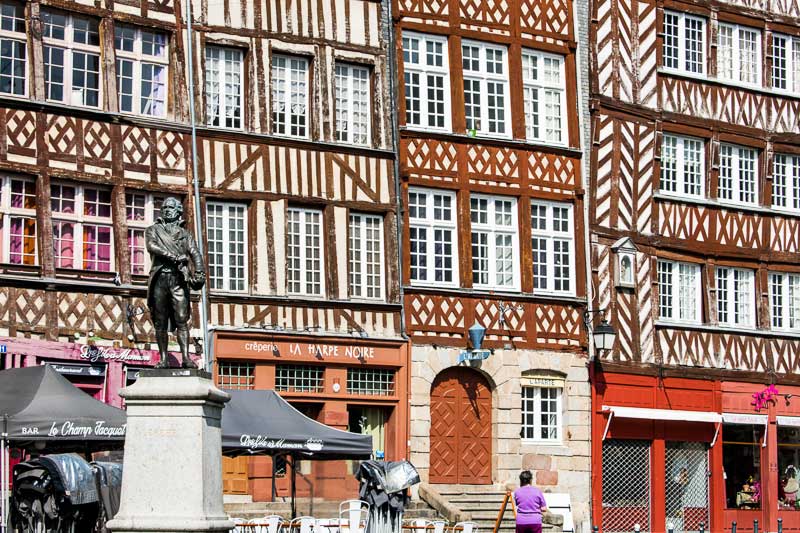

Leave a Reply